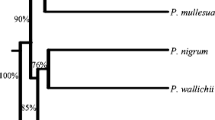Summary
The potential use of RAPDs for taxonomic studies were investigated using Brassica, Sinapis and Raphanus taxa. Principal coordinate analysis of 284 RAPD bands revealed the classical U triangle relationship between diploid and amphidiploid Brassica taxa. Raphanus sativus and S. alba were distinct from the Brassica taxa. It appears that at least ten primers with approximately 100 total bands are needed to adequately portray these relationships. Cultivars of cabbage and cauliflower were separated by RAPDs. Analysis of RAPDs from individual plants of B. carinata cv. dodola resulted in 69 RAPDs, with 91.7% monomorphic and 8.3% polymorphic bands. RAPDs appear to be useful for taxonomic studies at levels ranging from populations to species and perhaps genera.
Similar content being viewed by others
References
Adams RP (1975) Statistical character weighting and similarity stability. Brittonia 27:305–316
Caetano-Anolles G, Bassam BJ, Gresshoff PM (1991) High resolution DNA amplification fingerprinting using very short arbitrary oligonucleotide primers. BioTechnology 9:553–557
Carlson JE, Tulsieram LK, Glaubitz JC, Luk VWK, Kauffeldt C, Rutledge R (1991) Segregation of random amplified DNA markers in F1 progeny of conifers. Theor Appl Genet 83:194–200
Doyle JJ, Doyle JL (1987) A rapid DNA isolation procedure for small quantities of fresh leaf tissue. Phytochem Bull 19:11–15
Gower JC (1966) Some distance properties of latent root and vector methods used in multivariate analysis. Biometrika 53:315–328
Gower JC (1971) A general coefficient of similarity and some of its properties. Biometrics 27:857–874
Hosaka K, Kianian SF, McGrath JM, Quiros CF (1990) Development and chromosomal localization of genome-specific DNA markers of Brassica and the evolution of amphidiploids and n = 9 diploid species. Genome 33:131–142
Hu J, Quiros CF (1991) Identification of broccoli and cauliflower cultivars with RAPD markers. Plant Cell Rep 10:505–511
Klein-Lankhorst RM, Vermunt A, Weide R, Liharska T, Zabel P (1991) Isolation of molecular markers for tomato (L. esculentum) using random amplified polymorphic DNA (RAPD). Theor Appl Genet 83:108–114
Martin GB, Williams JGK, Tanksley SD (1991) Rapid identification of markers linked to a Pseudomonas resistance gene in tomato by using random primers and near-isogenic lines. Proc Natl Acad Sci USA 88:2336–2340
Michelmore RW, Paran I, Kessell RV (1991) Identification of markers linked to disease resistance genes by bulked segregant analysis: a rapid method to detect markers in specific genomic regions using segregating populations. Proc Natl Acad Sci USA 88:9828–9832
Mizushima U (1950) Karyogenetic studies of species and genus hybrids in the tribe Brassiceae of the Cruciferae. Tohoku J Agr Res 1:1–14
Palmer JD, Shields CR, Coehn DB, Orton TJ (1983) Chloroplast DNA evolution and the origin of amphidiploid Brassica species. Theor Appl Genet 65:181–189
Prakash S, Hinata K (1980) Taxonomy, cytogenetics and origin of crop Brassicas, a review. Opera Bot 55:1–57
Quiros CF, Ochoa O, Kianian SF, Douches DS (1987) Analysis of the Brassica oleracea genome by the generation of B. campestris-oleracea chromosome addition lines: characterization by isozymes and rDNA genes. Theor Appl Genet 74:758–766
Quiros CF, Hu J, This P, Chevre AM, Delseny M (1991) Development and chromosomal localization of genome-specific markers by the polymerase chain reaction. Theor Appl Genet 82:627–632
Rafalski JA, Tingey SV, Williams JGK (1991) RAPD markers — a new technology for genetic mapping and plant breeding. AgBiotech News Info 3:645–648
Song K, Osborn TC, Williams PH (1990) Brassica taxonomy based on nuclear restriction fragment length polymorphisms (RFLPs). 3. Genome relationships in Brassica and related genera and the origin of B. oleracea and B. rapa (syn. campestris). Theor Appl Gent 79:497–506
Vaughan JG (1977) A multidisciplinary study of the taxonomy and origin of Brassica crops. BioScience 27:35–40
U N (1935) Genomic analysis of Brassica with special reference to the experimental formation of B. napus and its peculiar mode of fertilization. Jpn J Bot 7:389–452
Welsh J, McClelland M (1990) Fingerprinting genomes using PCR with arbitrary primers. Nucleic Acids Res 18:7213–7218
Williams GK, Kubelik AR, Livak KL, Rafalski JA, Tingey SV (1990) DNA polymorphisms amplified by arbitrary primers are useful as genetic markers. Nucleic Acids Res 18:6531–6535
Author information
Authors and Affiliations
Additional information
Communicated by H. F. Linskens
Rights and permissions
About this article
Cite this article
Demeke, T., Adams, R.P. & Chibbar, R. Potential taxonomic use of random amplified polymorphic DNA (RAPD): a case study in Brassica . Theoret. Appl. Genetics 84, 990–994 (1992). https://doi.org/10.1007/BF00227415
Received:
Accepted:
Issue Date:
DOI: https://doi.org/10.1007/BF00227415




